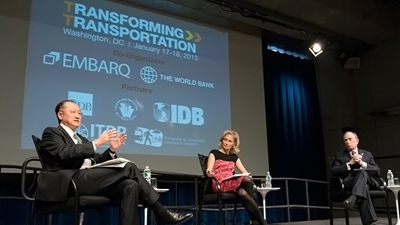The challenges cities face
Over the two days, the conference topics ranged from sustainable urban planning to making informal transport work for the majority, to creating safe commuting choices. Beijing, Mexico City, New York City, Quito, and Rio de Janeiro were among the cities sharing their experiences. Improving road safety in cities, and making informal transport work for the majority, were hotly debated topics.
In a blog post leading up to the conference, World Bank Vice President for Sustainable Development Rachel Kyte suggested, “Take a drive in Lagos and you’ll see the challenges cities face – and what they can do about them.”
Lagos, with some 11.2 million people, has locked-in traffic patterns and congested roads that can get thick with pollution. In 2002, the city decided to do something about it. With support from the World Bank, it began work on a bus rapid transport system, the first in sub-Saharan Africa. BRT commuters in Lagos today have reduced their transit time by 40 percent, and fares have dropped 30 percent on average, despite rising fuel costs. “Much more must be done, but we’re seeing progress,” said Kyte.
Big opportunities for action
Road traffic crashes cause more than 1.2 million deaths annually, about 90 percent of them in low- and middle-income countries. Conference participants heard how cities such as New York have adopted successful programs aimed at cutting traffic fatalities by 50 percent through a combination of traffic calming measures, slow school zones, protected bike lanes, and public campaigns.
India, with its rapidly growing urban population, was identified as a country with big challenges – and big opportunities. The country will have 200-230 million new urban residents by 2030. It is undergoing rapid motorization, with 12 million new two-wheelers in 2012. The country accounted for around 10 percent of road fatalities worldwide in 2008. And emissions from urban transport in India are set to increase five- to seven-fold in the next 20 years.
Madhav Pai, Director of EMBARQ India, gave the example of the city of Ahmedabad, where the population is predicted to rise to 13.2 million by 2040, up from 6.4 million in 2011 (and only 3.3 million in 1992).
There is great potential to limit urban sprawl in Ahmedabad by leveraging the mass transit system, Pai said. However, questions remain: Is there is enough funding available to build adequate public transport? And what policies and instruments will be needed to ensure land-use and transport integration?
Commitment to sustainable transport
The conference also discussed how to leverage one of the most important outcomes of the United Nations Conference on Sustainable Development (Rio+20) in June 2012: the commitment by the eight largest multilateral development banks (MDBs) to invest $175 billion in sustainable transportation over the next decade.
This commitment is a crucial response to a host of urgent issues felt by cities across the globe. Given the magnitude of investment needs, how can these funds catalyze a shift to more a sustainable trajectory?
“While all the MDBs are helping advance this agenda, implementation will require strong buy-in by the client countries themselves, together with a firm commitment to knowledge, capacity and awareness-building programs, and to coordinating among different policy domains,” said Jose Luis Irigoyen, World Bank Director for Transport, Water, and Information and Communication Technologies.
The effects of this concerted push are already visible in the share of the World Bank’s project portfolio going to sustainable transport loans with environmental, gender, accessibility, road safety, and social equity components.
For Holger Dalkmann, Director of EMBARQ, the $175 billion commitment was the signal of a shift which, to be set in motion, requires engagement from the MDBs with a wide set of stakeholders, starting with nongovernmental organizations. “The engagement is about correctly reallocating the money and creating a pull from the ground up, from cities to national governments, to the MDBs,” he said.
“Win-win-win”
One key challenge that countries and cities face, and which received attention throughout the conference, is the complexity of urban transport and the need to identify and implement holistic solutions, tailored to local needs.
Both Irigoyen and Dalkmann said their institutions stand ready to help build the partnerships and capacity needed to meet this challenge.
Wrapping up the two days of discussion, WRI President Andrew Steer emphasized the benefits of sustainable transport.
“If you get green transportation right, it pays for itself in terms of economics, in terms of environment, and in terms of human health and well-being,” he said. “It’s a wonderful win-win-win.”
Transforming Transportation 2013 was organized in partnership with the Asian Development Bank, the Clean Air Asia, the Institute for Transportation & Development Policy, the Inter-American Development Bank, and the Partnership on Sustainable Low Carbon Transport.
This article was prepared jointly by the World Bank and EMBARQ.

